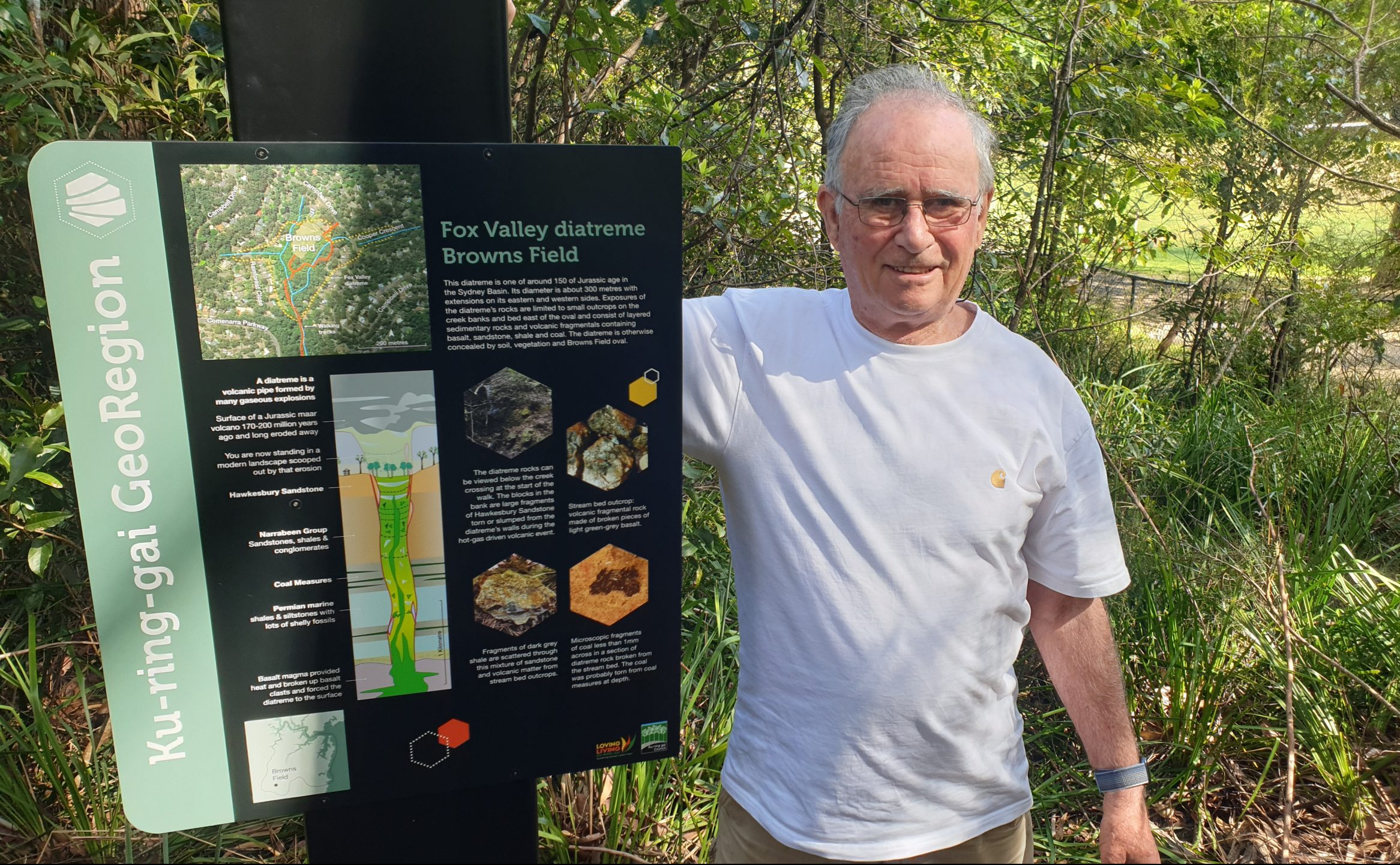Congratulations to Dr John Martin on his new book The Geology and Flora of the Sydney Basin.
Continue readingFirst Ku-ring-gai GeoRegion Trail Signage Installed: Fox Valley Diatreme, Browns Field
The ‘Ku-ring-gai GeoRegion (KGR), an area of approximately 440 sq km, is a community-backed project initiated by FOKE. The GeoRegion embraces the Ku-ring-gai Chase National Park, other bushland areas, as well as the coast and estuaries located just north of Sydney.
To understand the area covered by the Ku-ring-gai GeoRegion and its areas of importance, just click on this link to the Ku-ring-gai GeoRegion video.
The first geotrail signs have been installed to highlight the geology and biodiverstity evidenced at Browns Field in Wahroonga. Other proposed geotrails and geosites across the GeoRegion are being finalised to interpret the geological/landscape stories (inclusive of Aboriginal cultural heritage) that support the importance of the GeoRegion.
The Browns Field geotrail includes a number of geosites that are easily accessible and are interconnected around the now cleared parkland in the centre of the Fox Valley diatreme. A diatreme is a volcanic crater/plug formed by explosive eruptions which have then been eroded. Sites show highly weathered outcrops of fine to medium grained, quartz-poor fragmental volcanic rocks interlayered with much finer grained bedded rocks of possible crater-lake sediments.
Many rainforest plants unusual to the Sydney area are present, such as golden sassafras, jackwood, wild quince, giant maidenhair, fishbone water fern, strap water fern, and the sub-tropical rainforest tree – the koda (Ehretia acuminata). A population of the critically endangered scrub turpentine also persists at Browns Field.
An explanation of this geological setting has been captured within the newly designed and installed signage (pictured) funded by Ku-ring-gai Council and managed by KGR Steering Committee member, Dr John Martyn (also pictured).
Importantly, these sites and trails are both interesting and educational. The Browns Field diatreme is the first and worth a visit to explore and learn what we have in our backyard!
Ku-ring-gai GeoRegion Study a Major Step Forward
As highlighted previously, in 2018 FOKE initiated a project to add extra protections to, and increase awareness of, Ku-ring-gai’s natural heritage focusing originally on Ku-ring-gai Chase National Park.
This has since developed into a much broader area as we have advanced the proposal of a GeoRegion with Ku-ring-gai Chase as its centre, but extending from Berowra Valley, from the Hawkesbury River to northern Lane Cove National Park, east to the coast from Barrenjoey to Dee Why.
This large area, of approximately 44,000 ha, across northern Sydney showcases exceptional characteristics, with over 50 national and internationally significant geological environments of the Triassic sandstone landscapes of the Sydney Basin, unique and rare flora and fauna, and a density of Aboriginal sites that reflects the length of habitation in this area, with 1,424 sites currently recorded. A short video can be seen here Ku-ring-gai GeoRegion video
The proposal has been endorsed in principle by the Geological Survey of NSW and is supported by three local Councils (Hornsby, Ku-ring-gai, and Northern Beaches) and the National Parks and Wildlife Service, and local MPs. ‘ Geotrails’ identifying a network of key sites are being developed with appropriate interpretation, with the first of these expected to open in early 2023.
The Ku-ring-gai GeoRegion is also referenced and recognised in the Australian Government’s THRIVE 2030 Visitor Economy Strategy as having the potential to be one of three GeoRegions to be nominated as an Aspiring UNESCO Global Geopark for Australia.
On 17th November, the GeoRegion Steering Committee presented at the Linnean Society Sydney Symposium, highlighting the outstanding Natural and Cultural History of the Ku-ring-gai GeoRegion. A major co-authored technical study underpinned the presentations and is published in the current Linnean Society Proceedings journal.
The project Steering Committee believes that the contents of this study will form a solid basis for any proposed nomination submitted to UNESCO assessors. Here is the link to the GeoRegion Study.
It remains FOKE’s focus to ensure that our natural and cultural heritage is valued by the next generation as well as our growing number of residents. Only when areas are valued will communities fight for their conservation and protection.



